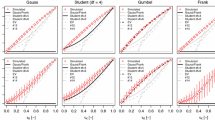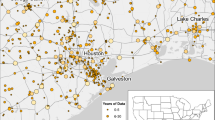Abstract
Uncertainty in return level estimates for rare events, like the intensity of large rainfall events, makes it difficult to develop strategies to mitigate related hazards, like flooding. Latent spatial extremes models reduce the uncertainty by exploiting spatial dependence in statistical characteristics of extreme events to borrow strength across locations. However, these estimates can have poor properties due to model misspecification: Many latent spatial extremes models do not account for extremal dependence, which is spatial dependence in the extreme events themselves. We improve estimates from latent spatial extremes models that make conditional independence assumptions by proposing a weighted likelihood that uses the extremal coefficient to incorporate information about extremal dependence during estimation. This approach differs from, and is simpler than, directly modeling the spatial extremal dependence; for example, by fitting a max-stable process, which is challenging to fit to real, large datasets. We adopt a hierarchical Bayesian framework for inference, use simulation to show the weighted model provides improved estimates of high quantiles, and apply our model to improve return level estimates for Colorado rainfall events with 1% annual exceedance probability.
Supplementary materials accompanying this paper appear online.



Similar content being viewed by others
References
Brown, B. M. and Resnick, S. I. (1977). Extreme values of independent stochastic processes. Journal of Applied Probability, 14(4):732–739.
Cao, Y. and Li, B. (2018). Assessing models for estimation and methods for uncertainty quantification for spatial return levels. Environmetrics.
Castruccio, S., Huser, R., and Genton, M. G. (2016). High-Order Composite Likelihood Inference for Max-Stable Distributions and Processes. Journal of Computational and Graphical Statistics, 25(4):1212–1229.
Coles, S. G. and Dixon, M. J. (1999). Likelihood-Based Inference for Extreme Value Models. Extremes, 2(1):5–23.
Cooley, D., Naveau, P., and Poncet, P. (2006). Variograms for spatial max-stable random fields. In Bertail, P., Doukhan, P., and Soulier, P., editors, Dependence in Probability and Statistics, pages 373–390. Springer Science+Business Media, LLC, New York, NY.
Cooley, D., Nychka, D., and Naveau, P. (2007). Bayesian Spatial Modeling of Extreme Precipitation Return Levels. Journal of the American Statistical Association, 102(479):824–840.
Cooley, D. and Sain, S. R. (2010). Spatial hierarchical modeling of precipitation extremes from a regional climate model. Journal of Agricultural, Biological, and Environmental Statistics, 15(3):381–402.
Cressie, N. A. C. (1993). Statistics for Spatial Data. John Wiley & Sons, Inc., Hoboken, NJ, revised edition.
Daly, C., Halbleib, M., Smith, J. I., Gibson, W. P., Doggett, M. K., Taylor, G. H., Curtis, J., and Pasteris, P. P. (2008). Physiographically sensitive mapping of climatological temperature and precipitation across the conterminous United States. International Journal of Climatology, 28(15):2031–2064.
Davison, A. C., Padoan, S. A., and Ribatet, M. (2012). Statistical Modeling of Spatial Extremes. Statistical Science, 27(2):161–186.
De Haan, L. (1984). A Spectral Representation for Max-stable Processes. The Annals of Probability, 12(4):1194–1204.
Gneiting, T. and Raftery, A. E. (2007). Strictly Proper Scoring Rules, Prediction, and Estimation. Journal of the American Statistical Association, 102(477):359–378.
Hans, C. (2009). Bayesian lasso regression. Biometrika, 96(4):835–845.
Hu, F. and Zidek, J. V. (2002). The weighted likelihood. The Canadian Journal of Statistics, 30(3):347–371.
Kabluchko, Z., Schlather, M., and de Haan, L. (2009). Stationary Max-Stable Fields Associated to Negative Definite Functions. The Annals of Probability, 37(5):2042–2065.
Karr, T. W. and Wooten, R. L. (1976). Summer Radar Echo Distribution Around Limon, Colorado. Monthly Weather Review, 104:728–734.
Lehmann, E. A., Phatak, A., Stephenson, A., and Lau, R. (2016). Spatial modelling framework for the characterisation of rainfall extremes at different durations and under climate change. Environmetrics, 27(4):239–251.
Lindgren, F., Rue, H., and Lindström, J. (2011). An explicit link between gaussian fields and gaussian markov random fields: The stochastic partial differential equation approach. Journal of the Royal Statistical Society. Series B: Statistical Methodology, 73(4):423–498.
MacEachern, S. N. and Berliner, L. M. (1994). Subsampling the Gibbs Sampler. The American Statistician, 48(3):188–190.
Martins, E. S. and Stedinger, J. R. (2000). Generalized maximum-likelihood generalized extreme-value quantile estimators for hydrologic data. Water Resources Research, 36(3):737–744.
Menne, M. J., Durre, I., Vose, R. S., Gleason, B. E., and Houston, T. G. (2012). An overview of the global historical climatology network-daily database. Journal of Atmospheric and Oceanic Technology, 29(7):897–910.
Newton, M. A. and Raferty, A. E. (1994). Approximate Bayesian Inference with the Weighted Likelihood Bootstrap. Journal of the Royal Statistical Society Series B, 56(1):3–48.
Opitz, T., Huser, R., Bakka, H., and Rue, H. (2018). INLA goes extreme : Bayesian tail regression for the estimation of high spatio-temporal quantiles. Extremes.
Padoan, S. A., Ribatet, M., and Sisson, S. A. (2010). Likelihood-Based Inference for Max-Stable Processes. Journal of the American Statistical Association, 105(489):263–277.
Park, T. and Casella, G. (2008). The Bayesian Lasso. Journal of the American Statistical Association, 103(482):681–686.
Reich, B. J. and Shaby, B. A. (2012). A Hierarchical Max-Stable Spatial Model for Extreme Precipitation. Annals of Applied Statistics, 6(4):1430–1451.
Ribatet, M., Cooley, D., and Davision, A. S. (2012). Bayesian inference from composite likelihoods, with an application to spatial extremes. Statistica Sinica, 22(2):813–845.
Rue, H., Martino, S., and Chopin, N. (2009). Approximate Bayesian inference for latent Gaussian models by using integrated nested Laplace approximations. Journal of the Royal Statistical Society: Series B (Statistical Methodology), 71(2):319–392.
Sang, H. and Gelfand, A. E. (2009). Hierarchical modeling for extreme values observed over space and time. Environmental and Ecological Statistics, 16(3):407–426.
Schlather, M. (2002). Models for stationary max-stable random fields. Extremes, 5(1):33–44.
Schlather, M. and Tawn, J. A. (2003). A Dependence Measure for Multivariate and Spatial Extreme Values: Properties and Inference. Biometrika, 90(1):139–156.
Schliep, E. M., Cooley, D., Sain, S. R., and Hoeting, J. A. (2010). A comparison study of extreme precipitation from six different regional climate models via spatial hierarchical modeling. Extremes, 13:219–239.
Sharkey, P. and Winter, H. C. (2018). A Bayesian spatial hierarchical model for extreme precipitation in Great Britain. Environmetrics.
Simpson, D., Rue, H., Riebler, A., Martins, T. G., and Sørbye, S. H. (2017). Penalising Model Component Complexity : A Principled , Practical Approach to Constructing Priors. Statistical Science, 32(1):1–28.
Smith, R. L. (1990). Max-Stable Processes and Spatial Extremes. Unpublished manuscript.
Thibaud, E., Aalto, J., Cooley, D. S., Davison, A. C., and Heikkinen, J. (2016). Bayesian inference for the BrownResnick process, with an application to extreme low temperatures. Annals of Applied Statistics, 10(4):2303–2324.
Tye, M. R. and Cooley, D. (2015). A spatial model to examine rainfall extremes in Colorado’s Front Range. Journal of Hydrology, 530:15–23.
Wang, X. (2006). Approximating Bayesian inference by weighted likelihood. The Canadian Journal of Statistics, 34(2):279–298.
Zheng, F., Thibaud, E., Leonard, M., and Westra, S. (2015). Assessing the performance of the independence method in modeling spatial extreme rainfall. Water Resources Research, 51:7744–7758.
Acknowledgements
This material is based upon work supported by the National Science Foundation under Grant No. AGS–1419558 (Hewitt and Hoeting) and DMS–1243102 (Fix and Cooley). This research utilized the CSU ISTeC Cray HPC System supported by NSF Grant CNS–0923386. This work utilized the RMACC Summit supercomputer, which is supported by the National Science Foundation (Awards ACI-1532235 and ACI-1532236), the University of Colorado Boulder, and Colorado State University. The Summit supercomputer is a joint effort of the University of Colorado Boulder and Colorado State University. We also express our gratitude to Emeric Thibaud and Mathieu Ribatet. Dr. Thibaud provided code to simulate Brown–Resnick processes, and Dr. Ribatet provided a development version of the SpatialExtremes package, written for the R computing language, that implements a Gibbs sampler for the unweighted latent spatial extremes model.
Author information
Authors and Affiliations
Corresponding author
Additional information
Publisher's Note
Springer Nature remains neutral with regard to jurisdictional claims in published maps and institutional affiliations.
Electronic supplementary material
Below is the link to the electronic supplementary material.
Rights and permissions
About this article
Cite this article
Hewitt, J., Fix, M.J., Hoeting, J.A. et al. Improved Return Level Estimation via a Weighted Likelihood, Latent Spatial Extremes Model. JABES 24, 426–443 (2019). https://doi.org/10.1007/s13253-019-00354-6
Received:
Accepted:
Published:
Issue Date:
DOI: https://doi.org/10.1007/s13253-019-00354-6




